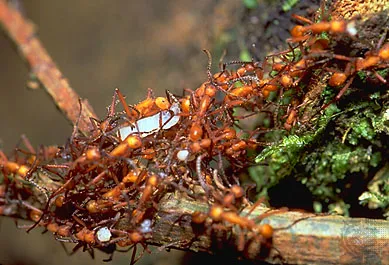: The Resilient Soldier Ant: A Glimpse into the Extraordinary World of Formicidae Warriors

In the intricate tapestry of the natural world, soldier ants emerge as valiant defenders, embodying the spirit of unity and sacrifice within their colonies. Forming an integral part of the social structure of ant colonies, these remarkable insects exhibit extraordinary traits that contribute to their collective success. This article delves into the fascinating world of soldier ants, exploring their anatomy, behavior, and crucial role in maintaining the delicate balance of their ecosystems.
The Anatomy of a Soldier Ant:
Soldier ants belong to the family Formicidae, a diverse group of insects known for their social organization. These ants exhibit distinct physical characteristics that set them apart from their worker counterparts. While worker ants primarily engage in foraging and maintaining the nest, soldier ants are equipped with specialized adaptations for defense.
The most noticeable feature of soldier ants is their enlarged mandibles, powerful jaws designed for combat. These formidable tools serve a dual purpose – they are not only used for defense against predators but also play a crucial role in cutting and carrying food back to the colony. The size and shape of mandibles vary across different ant species, reflecting their unique adaptations to specific environments.
In addition to their powerful mandibles, soldier ants often have larger heads and bodies compared to workers. This enhanced size contributes to their overall strength and makes them well-suited for their defensive roles. Some species also boast intricate patterns or colors on their exoskeletons, further distinguishing them within the colony.
Behavioral Adaptations:
Soldier ants exhibit a range of behavioral adaptations that complement their physical attributes. One of the most remarkable features of their behavior is the selfless dedication to colony defense. When the colony is threatened, soldier ants swiftly mobilize, forming a united front against the intruder.
Communication within ant colonies relies heavily on chemical signals known as pheromones. Soldier ants release specific pheromones that serve as alarm signals, alerting other members of the colony to potential danger. This rapid communication allows for a coordinated response, with workers and soldiers working in tandem to safeguard the nest.
Interestingly, some soldier ants are known to engage in a behavior called phragmosis, where they use their bodies to block nest entrances and create a barricade against potential threats. This physical obstruction, combined with the release of alarm pheromones, creates a formidable line of defense that deters predators and rival ant colonies.
Ecological Impact:
Beyond their role within ant colonies, soldier ants play a crucial ecological role in their environments. By defending their colonies against herbivores and predators, they contribute to the overall health of ecosystems. The absence of effective defense mechanisms within ant colonies could lead to destabilization and potential collapse, impacting the balance of local flora and fauna.
In some cases, soldier ants engage in mutualistic relationships with other organisms. Certain ant species form alliances with plants, protecting them from herbivores in exchange for food and shelter. This intricate web of relationships highlights the interconnectedness of species within ecosystems, with soldier ants acting as key players in maintaining this delicate balance.
Adaptations to Varied Environments:
The resilience of soldier ants is evident in their ability to adapt to a wide range of environments. Whether inhabiting tropical rainforests, arid deserts, or temperate woodlands, these ants have evolved to thrive in diverse conditions. Their adaptability is reflected not only in their physical traits but also in their behavioral strategies for survival.
In arid regions, some species of soldier ants have developed the ability to withstand extreme temperatures and water scarcity. Their nests are constructed to retain moisture, and they exhibit behaviors such as foraging during cooler periods of the day to minimize water loss. In contrast, species in humid environments may face different challenges, such as fungal infections, and have evolved mechanisms to combat these threats.
The Role of Soldier Ants in Agriculture:
While soldier ants are renowned for their defensive capabilities, they can also influence agricultural landscapes, both positively and negatively. In some cases, they act as natural predators, controlling pest populations that could otherwise damage crops. Farmers in various regions have recognized the potential benefits of harnessing the ecological services provided by soldier ants to enhance sustainable agriculture.
However, in certain situations, soldier ants can pose challenges to agriculture. Some species are known to cultivate fungus within their nests, relying on these fungal gardens as a primary food source. In doing so, they may inadvertently damage crops or other vegetation. Understanding the intricate dynamics between soldier ants and agriculture is crucial for implementing effective pest management strategies that balance ecological conservation with agricultural productivity.
Conclusion:
In the intricate tapestry of the natural world, soldier ants stand as resilient defenders, embodying the principles of cooperation, sacrifice, and adaptability. Their unique anatomy, behavioral adaptations, and ecological impact make them indispensable contributors to the delicate balance of ecosystems. As we continue to unravel the mysteries of these remarkable insects, a deeper appreciation for their role in nature emerges, underscoring the importance of preserving the diverse and interconnected web of life on our planet.
-
What is a soldier ant?
A soldier ant is a specialized member of an ant colony that is primarily responsible for defending the nest against predators and other threats. They exhibit distinct physical characteristics and behaviors that set them apart from worker ants within the colony.
-
How can you distinguish a soldier ant from other ants?
Soldier ants often have larger heads and bodies compared to worker ants. Their mandibles are enlarged and adapted for combat, serving as a key feature that distinguishes them. Some species also exhibit unique patterns or colors on their exoskeletons.
- What is the role of soldier ants within an ant colony?
The primary role of soldier ants is colony defense. They use their specialized mandibles and other physical adaptations to protect the nest from predators, rival ant colonies, and potential threats. They are also involved in foraging and transporting food back to the colony.
-
Do all ant colonies have soldier ants?
While not all ant species have distinct soldier ants, many social ant species exhibit a caste system with specialized individuals for various tasks. Soldier ants are more commonly found in species where colony defense is crucial for survival.
-
How do soldier ants communicate within the colony?
Communication within ant colonies is largely facilitated through chemical signals called pheromones. Soldier ants release alarm pheromones when the colony is under threat, alerting other members to the danger and prompting a coordinated defensive response.
-
What are the main threats faced by soldier ants?
Soldier ants face various threats, including predators, competing ant colonies, and environmental challenges. Some species may also encounter risks associated with fungal infections or other diseases.
-
Do soldier ants engage in battles with other ant colonies?
Yes, soldier ants are actively involved in defending their colonies against rival ant colonies. These battles can be intense, with soldiers using their mandibles and coordinated strategies to protect their nest and resources.
-
How do soldier ants contribute to their ecosystems?
Soldier ants play a crucial role in maintaining the balance of ecosystems by defending their colonies against herbivores and predators. Their presence helps control pest populations and contributes to the overall health of local flora and fauna.
-
Can soldier ants be harmful to agriculture?
In some cases, soldier ants may pose challenges to agriculture, especially if they cultivate fungus within their nests or if their foraging habits damage crops. However, they can also act as natural predators, controlling pest populations and benefiting agriculture.
-
Are there different types of soldier ants?
Yes, there are various species of soldier ants, each with unique adaptations based on their environments. The size, shape, and behavior of soldier ants can vary significantly between species, reflecting their diverse roles and ecological niches.
-
How do soldier ants adapt to different environments?
Soldier ants exhibit remarkable adaptability to different environments. Their physical traits and behaviors may vary based on factors such as temperature, humidity, and the specific challenges posed by each habitat. Some species have evolved specific strategies to thrive in arid or humid conditions.
-
Do soldier ants have any positive impact on human activities?
Yes, soldier ants can have a positive impact on human activities, particularly in agriculture. Some species act as natural predators, helping to control pest populations and reduce the need for chemical pesticides, contributing to more sustainable farming practices.






